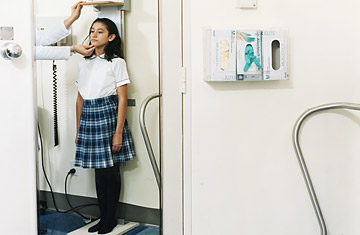
Growth spurts are good — unless they happen too fast and too soon. Then they could suggest premature puberty
(2 of 7)
It's difficult to establish a historical norm for the average age of menarche (a girl's first menstruation), since so much depends on general health and nutrition, social class and other external factors. When the average human life span was 40 or less, menarche, of necessity, came early. Longer-lived people had the evolutionary luxury of starting later. Malnutrition could delay menstruation too, while ample food supplies produced populations in which women were strong enough to carry babies earlier. Nutrition is one thing that pushed the average age of first menstruation down to about 13 by the middle of the 20th century--in the developed world, at least--and there it stayed for a few decades.
But by the 1980s, the onset of puberty, if not actual menstruation, had gone into free fall--a change so sudden and pronounced that something more than normal evolution must have been at work. In a landmark 1997 study of 17,000 girls, Marcia Herman-Giddens, a professor of public health at the University of North Carolina, reported that more than 10% of white girls and an astonishing 37.8% of black girls were showing early breast development by age 8. A smaller but still alarming share of girls--5% of whites and 15% of blacks--had breasts budding at age 7. Later studies, one in 1998 and another in 2010, included Hispanics and produced similar results. On average, 2 out of every 10 white girls, 3 out of 10 Latinas and 4 out of 10 black girls are showing breast development by age 8. Such baby teens have become so common that in the U.S., puberty is not even diagnosed as clinically premature unless it occurs before a girl's eighth birthday.
For boys, the numbers are less certain, for several reasons. There is no clear external marker like breast size to go by, and the closest biological analogy to first menstruation--first ejaculation--is rarely viewed as a cause for worry. The only real measure of the onset of puberty is growth in genital size, particularly the testes, but the kids themselves may not even notice, and the exam needed to confirm a change is not a pleasant one.
Even in cases in which careful, peer-reviewed studies have been conducted, the results, Herman-Giddens says, "have been all over the place." All the same, the problem is common enough, at least anecdotally, that for boys too the clinical threshold for precocious puberty is unsettlingly young: just 9 years old.
What's Speeding Things Up?
For a phenomenon that causes such profound physical changes, the onset of puberty plays out in a relatively simple way. At a precise moment determined by, well, no one knows just what, the hypothalamus, a small structure deep inside the brain, begins producing what's known as a gonadotropin-releasing hormone (GnRH), which signals the pituitary gland to churn out two other substances--a luteinizing hormone and a follicle-stimulating hormone--and dump them into the bloodstream. Those chemicals then instruct the ovaries and testes to begin producing estrogen and testosterone, and the bodily transformation begins.
